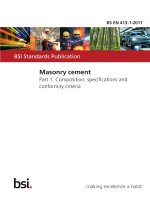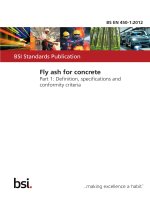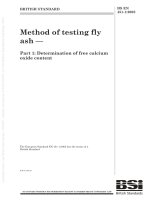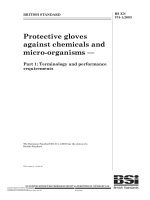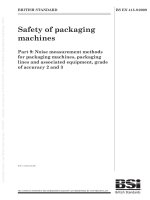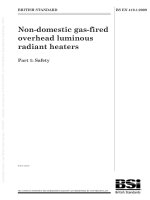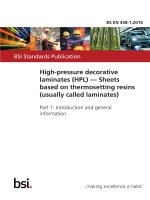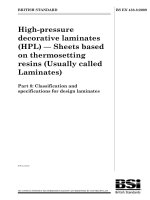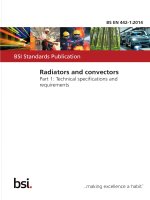Bsi bs en 61606 1 2009
Bạn đang xem bản rút gọn của tài liệu. Xem và tải ngay bản đầy đủ của tài liệu tại đây (1.19 MB, 34 trang )
Licensed Copy: athen reading, Reading University Library, 23/01/2010 05:08, Uncontrolled Copy, (c) BSI
BS EN 61606-1:2009
BSI Standards Publication
Audio and audiovisual
equipment — Digital audio
parts — Basic measurement
methods of audio
characteristics —
Part 1: General
NO COPYING WITHOUT BSI PERMISSION EXCEPT AS PERMITTED BY COPYRIGHT LAW
raising standards worldwide™
BRITISH STANDARD
Licensed Copy: athen reading, Reading University Library, 23/01/2010 05:08, Uncontrolled Copy, (c) BSI
BS EN 61606-1:2009
National foreword
This British Standard is the UK implementation of EN 61606-1:2009. It is
identical to IEC 61606-1:2009. It supersedes BS EN 61606-1:2004 which is
withdrawn.
The UK participation in its preparation was entrusted to Technical Committee
EPL/100, Audio, video and multimedia systems and equipment.
A list of organizations represented on this committee can be obtained on
request to its secretary.
This publication does not purport to include all the necessary provisions of a
contract. Users are responsible for its correct application.
© BSI 2010
ISBN 978 0 580 60898 8
ICS 33.160.01
Compliance with a British Standard cannot confer immunity from
legal obligations.
This British Standard was published under the authority of the Standards
Policy and Strategy Committee on 31 January 2010
Amendments issued since publication
Amd. No.
Date
Text affected
Licensed Copy: athen reading, Reading University Library, 23/01/2010 05:08, Uncontrolled Copy, (c) BSI
BS EN 61606-1:2009
EUROPEAN STANDARD
EN 61606-1
NORME EUROPÉENNE
November 2009
EUROPÄISCHE NORM
ICS 33.160.01
Supersedes EN 61606-1:2004
English version
Audio and audiovisual equipment Digital audio parts Basic measurement methods of audio characteristics Part 1: General
(IEC 61606-1:2009)
Equipements audio et audiovisuels Parties audionumériques Méthodes fondamentales
pour la mesure
des caractéristiques audio Partie 1: Généralités
(CEI 61606-1:2009)
Audio- und audiovisuelle Geräte Digitale Tonteile Grundlegende Messverfahren
der Audio-Eigenschaften Teil 1: Allgemeines
(IEC 61606-1:2009)
This European Standard was approved by CENELEC on 2009-09-01. CENELEC members are bound to comply
with the CEN/CENELEC Internal Regulations which stipulate the conditions for giving this European Standard
the status of a national standard without any alteration.
Up-to-date lists and bibliographical references concerning such national standards may be obtained on
application to the Central Secretariat or to any CENELEC member.
This European Standard exists in three official versions (English, French, German). A version in any other
language made by translation under the responsibility of a CENELEC member into its own language and notified
to the Central Secretariat has the same status as the official versions.
CENELEC members are the national electrotechnical committees of Austria, Belgium, Bulgaria, Cyprus, the
Czech Republic, Denmark, Estonia, Finland, France, Germany, Greece, Hungary, Iceland, Ireland, Italy, Latvia,
Lithuania, Luxembourg, Malta, the Netherlands, Norway, Poland, Portugal, Romania, Slovakia, Slovenia, Spain,
Sweden, Switzerland and the United Kingdom.
CENELEC
European Committee for Electrotechnical Standardization
Comité Européen de Normalisation Electrotechnique
Europäisches Komitee für Elektrotechnische Normung
Central Secretariat: Avenue Marnix 17, B - 1000 Brussels
© 2009 CENELEC -
All rights of exploitation in any form and by any means reserved worldwide for CENELEC members.
Ref. No. EN 61606-1:2009 E
Licensed Copy: athen reading, Reading University Library, 23/01/2010 05:08, Uncontrolled Copy, (c) BSI
BS EN 61606-1:2009
EN 61606-1:2009
-2-
Foreword
The text of document 100/1547/FDIS, future edition 2 of IEC 61606-1, prepared by IEC TC 100, Audio,
video and multimedia systems and equipment, was submitted to the IEC-CENELEC parallel vote and was
approved by CENELEC as EN 61606-1 on 2009-09-01.
This European Standard supersedes EN 61606-1:2004.
The significant technical changes with respect to EN 61606-1:2004 are the following:
– changed the period of preconditioning;
– add A weighting filter in measuring instruments;
– correct the wrong reference number;
– some inappropriate descriptions have been improved.
The following dates were fixed:
– latest date by which the EN has to be implemented
at national level by publication of an identical
national standard or by endorsement
(dop)
2010-06-01
– latest date by which the national standards conflicting
with the EN have to be withdrawn
(dow)
2012-09-01
Annex ZA has been added by CENELEC.
__________
Endorsement notice
The text of the International Standard IEC 61606-1:2009 was approved by CENELEC as a European
Standard without any modification.
In the official version, for Bibliography, the following note has to be added for the standard indicated:
IEC 61938
NOTE Harmonized as EN 61938:1997 (not modified).
__________
Licensed Copy: athen reading, Reading University Library, 23/01/2010 05:08, Uncontrolled Copy, (c) BSI
BS EN 61606-1:2009
-3-
EN 61606-1:2009
Annex ZA
(normative)
Normative references to international publications
with their corresponding European publications
The following referenced documents are indispensable for the application of this document. For dated
references, only the edition cited applies. For undated references, the latest edition of the referenced
document (including any amendments) applies.
NOTE When an international publication has been modified by common modifications, indicated by (mod), the relevant EN/HD
applies.
Publication
Year
Title
3)
1992
3)
HD 483.2 S2
1993
3)
EN 60268-3
+ corr. January
2000
2002
3)
EN 60958
Series
1)
Sound system equipment Part 2: Explanation of general terms and
calculation methods
1)
Sound system equipment Part 3: Amplifiers
–
IEC 60268-2
–
IEC 60268-3
–
IEC 60958
Series Digital audio interface
1)
Methods of measurement on receivers for
satellite broadcast transmissions in the
12 GHz band Part 4: Electrical measurements on
sound/data decoder units for the digital
subcarrier/NTSC system
-
-
1)
Methods of measurement on receivers for
satellite broadcast transmissions in the
12 GHz band Part 5: Electrical measurements on decoder
units for MAC/Packet systems
EN 61079-5
1993
3)
1)
Audio and audiovisual equipment - Digital
EN 61606-2
audio parts - Basic measurement methods of
audio characteristics Part 2: Consumer use
2009
3)
1)
EN 61606-3
Audio and audiovisual equipment - Digital
audio parts - Basic measurement methods of
audio characteristics Part 3: Professional use
2008
3)
IEC 61079-4
–
IEC 61079-5
–
IEC 61606-2
–
IEC 61606-3
–
3)
1989
2002
1995
Recommended methods of measurement on EN 60107-5
receivers for television broadcast
transmissions Part 5: Electrical measurements on
multichannel sound television receivers using
the NICAM two-channel digital sound-system
IEC 60107-5
2)
HD 472 S1
+ corr. February
A1
1)
–
1)
Year
IEC standard voltages
IEC 60038
2)
EN/HD
1)
Undated reference.
The title of HD 472 S1 is: Nominal voltages for low-voltage public electricity supply systems.
Valid edition at date of issue.
Licensed Copy: athen reading, Reading University Library, 23/01/2010 05:08, Uncontrolled Copy, (c) BSI
BS EN 61606-1:2009
EN 61606-1:2009
Publication
-4Year
Title
EN/HD
Year
1)
Audio and audiovisual equipment - Digital
EN 61606-4
audio parts - Basic measurements methods of
audio characteristics Part 4: Personal computer
2006
3)
1)
Electroacoustics - Sound level meters Part 1: Specifications
EN 61672-1
2003
3)
1)
Consumer audio/video equipment - Digital
interface Part 6: Audio and music data transmission
EN 61883-6
2005
3)
1)
Measurement of audio-frequency noise
voltage level in sound broadcasting
-
-
1)
AES standard method for digital audio
engineering - Measurement of digital audio
equipment
-
-
IEC 61606-4
–
IEC 61672-1
–
IEC 61883-6
–
ITU-R BS 468-4
–
AES 17
–
Licensed Copy: athen reading, Reading University Library, 23/01/2010 05:08, Uncontrolled Copy, (c) BSI
BS EN 61606-1:2009
–2–
61606-1 © IEC:2009(E)
CONTENTS
1
Scope ...............................................................................................................................6
2
Normative references .......................................................................................................6
3
Terms, definitions, explanations and rated values ............................................................7
4
3.1 Terms and definitions ..............................................................................................7
3.2 Explanation of term “jitter” .......................................................................................9
3.3 Rated values ...........................................................................................................9
Measuring conditions...................................................................................................... 10
4.1
4.2
5
Environmental conditions ...................................................................................... 10
Power supply......................................................................................................... 10
4.2.1 Supply voltage ........................................................................................... 10
4.2.2 Frequency(ies) .......................................................................................... 10
4.2.3 High-frequency and harmonic components (or ripples) in the power
supply output ............................................................................................. 10
4.3 Test signal frequencies ......................................................................................... 10
4.4 Standard setting .................................................................................................... 11
4.4.1 Standard input conditions for the EUT ....................................................... 11
4.4.2 Standard output conditions for the EUT ..................................................... 12
4.4.3 Standard setting of controls ....................................................................... 12
4.5 Preconditioning ..................................................................................................... 12
4.6 Measuring instruments .......................................................................................... 13
4.6.1 General ..................................................................................................... 13
4.6.2 Signal generator ........................................................................................ 13
4.6.3 Filter.......................................................................................................... 15
4.6.4 Level meter ............................................................................................... 16
4.6.5 Distortion meter ......................................................................................... 17
4.6.6 Frequency meter ....................................................................................... 18
4.6.7 Group delay meter ..................................................................................... 18
4.6.8 Analogue spectrum analyzer...................................................................... 19
4.6.9 Digital waveform monitor ........................................................................... 19
4.6.10 Voltage amplifier ....................................................................................... 19
4.6.11 Standard digital player ............................................................................... 20
Methods of measurement (digital-in/analogue-out) ......................................................... 20
5.1
5.2
5.3
5.4
5.5
General ................................................................................................................. 20
Input/output characteristics ................................................................................... 20
5.2.1 Maximum output amplitude ........................................................................ 20
5.2.2 Gain difference between channels and tracking error ................................ 20
Frequency characteristics...................................................................................... 21
5.3.1 Frequency response .................................................................................. 21
5.3.2 Group delay (phase linearity) ..................................................................... 21
Noise characteristics ............................................................................................. 21
5.4.1 Signal-to-noise ratio (idle channel noise) ................................................... 21
5.4.2 Dynamic range .......................................................................................... 22
5.4.3 Out-of-band noise ratio .............................................................................. 22
5.4.4 Channel separation ................................................................................... 22
Distortion characteristics ....................................................................................... 23
Licensed Copy: athen reading, Reading University Library, 23/01/2010 05:08, Uncontrolled Copy, (c) BSI
BS EN 61606-1:2009
61606-1 © IEC:2009(E)
6
–3–
5.5.1 Level non-linearity ..................................................................................... 23
5.5.2 Distortion and noise................................................................................... 23
5.5.3 Intermodulation.......................................................................................... 23
Methods of measurement (analogue-in/digital-out) ......................................................... 23
6.1
6.2
General ................................................................................................................. 23
Input/output characteristics ................................................................................... 23
6.2.1 Analogue to digital level calibration ........................................................... 23
6.2.2 Maximum allowable input amplitude........................................................... 24
6.2.3 Gain difference between channel and tracking error .................................. 24
6.3 Frequency characteristics...................................................................................... 24
6.3.1 Frequency response .................................................................................. 24
6.3.2 Group delay............................................................................................... 25
6.4 Noise characteristics ............................................................................................. 25
6.4.1 Signal-to-noise ratio (idle channel noise) ................................................... 25
6.4.2 Dynamic range .......................................................................................... 25
6.4.3 Folded noise.............................................................................................. 26
6.4.4 Cross-talk .................................................................................................. 26
6.4.5 Channel separation ................................................................................... 26
6.5 Distortion characteristics ....................................................................................... 26
6.5.1 Level non-linearity ..................................................................................... 26
6.5.2 Distortion and noise................................................................................... 27
6.5.3 Intermodulation.......................................................................................... 27
Bibliography.......................................................................................................................... 28
Figure 1 – Analogue test signal waveform ............................................................................. 14
Figure 2 – Digital test signal waveform ................................................................................. 14
Table 1 – Actual frequencies used in the measurement ........................................................ 11
Table 2 – Impulse conditions and measuring range............................................................... 19
Licensed Copy: athen reading, Reading University Library, 23/01/2010 05:08, Uncontrolled Copy, (c) BSI
BS EN 61606-1:2009
–6–
61606-1 © IEC:2009(E)
AUDIO AND AUDIOVISUAL EQUIPMENT –
DIGITAL AUDIO PARTS –
BASIC MEASUREMENT METHODS
OF AUDIO CHARACTERISTICS –
Part 1: General
1
Scope
This part of IEC 61606 is applicable to the basic methods of measurement of the audio
characteristics of the digital audio part of audio and audiovisual equipment for all of consumer
use, professional use and personal computer.
The common measuring conditions and methods, described in this standard, are used for the
measurement of the performance characteristics of equipment having an audio bandwidth
equal to approximately one-half of the sampling frequency of a system, where the audio
information is processed in the form of digital data. CD players, DAT recorders, digital
amplifiers, digital sound broadcast receivers and television broadcast receivers with digital
sound are examples.
This standard describes test methods for equipment which has digital input with analogue
output and analogue input with digital output. Future revisions of this standard will cover
digital-in/digital-out and analogue-in/analogue-out tests.
This standard does not apply to a lossy compression signal and also does not apply to power
amplifiers.
NOTE 1 A digital audio system having an analogue input and an analogue output with digital signal processing
may have different characteristics from those of a pure analogue audio system due to sampling of the audio signal
and performance of incorporated A/D and D/A converters. Measurement methods described in IEC 60268-3 may
not give correct results when applied to a digital system.
NOTE 2
The methods described are mostly based on sampling frequencies of 32 kHz and higher.
NOTE 3
AES17.
For tests of those systems of digital-in – digital-out, and analogue-in – analogue-out tests, refer to
NOTE 4
2i50.
This standard is planned to harmonize with the first edition of IEC 61606 (1997) 1, AES17 and EIAJ CP-
2
Normative references
The following referenced documents are indispensable for the application of this document.
For dated references, only the edition cited applies. For undated references, the latest edition
of the referenced document (including any amendments) applies.
IEC 60038,
IEC standard voltages
IEC 60107-5, Recommended methods of measurement on receivers for television broadcast
transmissions – Part 5: Electrical measurements on multichannel sound television receivers
using the NICAM two-channel digital sound system
—————————
1 IEC 61606:1997, Audio and audiovisual equipment – Digital audio parts – Basic methods of measurement of
audio characteristics (this publication has been replaced by the IEC 61606 series)
Licensed Copy: athen reading, Reading University Library, 23/01/2010 05:08, Uncontrolled Copy, (c) BSI
BS EN 61606-1:2009
61606-1 © IEC:2009(E)
–7–
IEC 60268-2, Sound system equipment – Part 2: Explanation of general terms and
calculation methods
IEC 60268-3,
Sound system equipment – Part 3: Amplifiers
IEC 60958 (all parts),
Digital audio interface
IEC 61606-2, Audio and audiovisual equipment – Digital audio parts – Basic measurement
methods of audio characteristics – Part 1: Consumer use
IEC 61606-3, Audio and audiovisual equipment – Digital audio parts – Basic measurement
methods of audio characteristics – Part 3: Professional use
IEC 61606-4, Audio and audiovisual equipment – Digital audio parts – Basic measurement
methods of audio characteristics – Part 4: Personal computer
IEC 61079-4, Methods of measurement on receivers for satellite broadcast transmissions in
the 12 GHz band – Part 4: Electrical measurements on sound/data decoder units for the
digital subcarrier NTSC system
IEC 61079-5, Methods of measurement on receivers for satellite broadcast transmissions in
the 12 GHz band – Part 5: Electrical measurements on decoder units for MAC/packet systems
IEC 61672-1,
Electroacoustics – Sound level meters – Part 1: Specifications
IEC 61883-6, Consumer audio/video equipment – Digital interface – Part 6: Audio and music
data transmission protocol
ITU-R BS 468-4,
Measurement of audio-frequency noise voltage level in sound broadcasting
AES17, AES standard method for digital audio engineering – Measurement of digital audio
equipment
3
Terms, definitions, explanations and rated values
3.1
Terms and definitions
For the purposes of this document, the following terms and definitions apply.
3.1.1
aliasing components
output frequency components below the folding frequency made from the input signal above
the folding frequency
3.1.2
analogue full-scale amplitude
nominal signal level at the analogue input of an EUT corresponding to the digital full-scale
level
3.1.3
coding format
series of data bit stream with control information in accordance with the standard for which
the EUT is designed, such as IEC 60958, IEC 61883-6 or some kind of AV interface
NOTE
A coding word is arranged as a 2’s complimentary binary form in this standard.
Licensed Copy: athen reading, Reading University Library, 23/01/2010 05:08, Uncontrolled Copy, (c) BSI
BS EN 61606-1:2009
–8–
61606-1 © IEC:2009(E)
3.1.4
digital audio signal
series of digital signals expressed by sampled data
NOTE
This data is constructed with LPCM (Linear Pulse Code Modulation) data.
3.1.5
digital interface for measurement
type of input or output digital interface which is used for measurement, such as IEC 60958,
IEC 61883-6 or some kind of AV interface
NOTE
Details are defined in IEC 61606-2 (consumer use) or IEC 61606-3 (professional use).
3.1.6
digital signal generator
all types of digital generators, which including digital sine signal generators or package media
or RF signal generators
3.1.7
digital zero
signal that has a value consisting of all zeroes for all samples
3.1.8
equipment under test
EUT
equipment to be measured using the methods described in this standard
3.1.9
folding frequency
one half the sampling frequency of the digital system
NOTE
Signals applied to the input with frequency components higher than this frequency are subject to aliasing.
3.1.10
full-scale level
FS
signal level of a sine wave whose positive peak value reaches the positive digital full scale,
leaving the negative maximum code unused
EXAMPLE
The largest positive value is 7FFFH and the largest negative value is 8001H in 16 bit data.
3.1.11
in-band frequency range
frequency range from 4 Hz to upper band-edge frequency (see 3.1.19).
3.1.12
jitter
deviation of the timing of the transitions of a clock signal from their ideal or nominal times
3.1.13
normal load impedance
impedance which is connected to output terminals of EUT
NOTE The concrete value is defined in IEC 61606-2 (consumer use) or IEC 61606-3 (professional use) or
IEC 61606-4 (PC use).
3.1.14
normal measuring level
signal level equal to –20 dB FS
Licensed Copy: athen reading, Reading University Library, 23/01/2010 05:08, Uncontrolled Copy, (c) BSI
BS EN 61606-1:2009
61606-1 © IEC:2009(E)
–9–
3.1.15
normal source impedance
impedance which is connected to input terminals of EUT
NOTE
The concrete value is defined in IEC 61606-2 (consumer use) or IEC 61606-3 (professional use)
IEC 61606-4 (PC use).
3.1.16
out-of-band frequencies
frequency range from folding frequency to 500 kHz.
NOTE
Signals applied to the input in this frequency range are subject to aliasing.
3.1.17
sampling frequency
fs
number of samples of a signal taken per unit time
3.1.18
signal level
dB FS
result obtained from the following equation:
signal level (dB FS ) = 20 log 10 (A/B)
where A is the r.m.s. value of the signal whose level is to be determined, and B is the r.m.s.
value of a sine wave which corresponds to full-scale level in digital data or to analogue fullscale level in analogue signals
3.1.19
upper band-edge frequency
frequency calculated by the equation:
f s × 0,46
NOTE If f s is higher than 44,1 kHz, the manufacturer may define the upper band-edge frequency between 20 kHz
and f s × 0,46. In this case, the upper band-edge frequency should be stated in the system description by the
manufacturer.
3.1.20
word length
number of bits of a data element
NOTE
The least significant bit of the data element should not be ignored.
3.2
Explanation of term “jitter”
The performance of conversion processes are potentially affected by jitter present on the
synchronization input, the digital audio inputs, or both. For example, if the sampling clock for
the analogue-to-digital converter inside the EUT is derived from or locked to either the
synchronization input or a digital audio input, jitter present on that input can degrade
conversion accuracy.
There are various types of jitter susceptibility to be considered such as analogue-to-digital
jitter susceptibility, digital-to-analogue susceptibility, and digital-to-digital susceptibility. See
AES17 for detailed discussion on the subject.
3.3
Rated values
For a full explanation of these terms, see IEC 60268-2. The following are rated conditions for
digital audio equipment and should be specified by the manufacturer:
Licensed Copy: athen reading, Reading University Library, 23/01/2010 05:08, Uncontrolled Copy, (c) BSI
BS EN 61606-1:2009
– 10 –
•
rated supply voltage;
•
rated supply frequency;
•
rated pre-emphasis and de-emphasis characteristics;
•
rated digital input word length;
•
rated sampling frequencies.
4
Measuring conditions
4.1
Environmental conditions
Air pressure
96 kPa ± 10 kPa
Ambient temperature
15 °C to 35 °C
Relative humidity
60 % ± 15 %
4.2
4.2.1
61606-1 © IEC:2009(E)
Power supply
Supply voltage
The rated power supply voltage, as specified in IEC 60038, shall be used. The tolerance of
the supply voltage should be ±1 % or less. A tolerance of up to ±10 % may be allowed if the
results of the measurements are not noticeably affected.
4.2.2
Frequency(ies)
The power supply frequency(ies) specified by the manufacturer shall be used. The tolerance
of the frequency should be ±2 % or less. A d.c. power supply may be used if specified.
4.2.3
High-frequency and harmonic components (or ripples) in the power supply
output
High-frequency components in the power supply output should be less than the level which
affects the result of measurement.
4.3
Test signal frequencies
The frequency of the test signal shall be selected from the actual values in Table 1. In
catalogues and other documents, where precision is not required or implied in the description,
it is permitted to use the normal figures shown in Table 1. Unless otherwise specified, the
reference frequency for measurements shall be 997 Hz, which may be stated in non-critical
contexts, as 1 kHz.
Licensed Copy: athen reading, Reading University Library, 23/01/2010 05:08, Uncontrolled Copy, (c) BSI
BS EN 61606-1:2009
61606-1 © IEC:2009(E)
– 11 –
Table 1 – Actual frequencies used in the measurement
Actual frequency
Nominal
Hz
Hz
fs =
32 kHz
fs =
44,1 kHz
fs =
48 kHz
fs =
88,2 kHz
fs =
96 kHz
fs =
176,4 kHz
fs =
192 kHz
4
4
4
4
4
4
4
4
8
7
7
7
7
7
7
7
16
17
17
17
17
17
17
17
32
31
31
31
31
31
31
31
63
61
61
61
61
61
61
61
125
127
127
127
127
127
127
127
250
251
251
251
251
251
251
251
500
499
499
499
499
499
499
499
1 000
997
997
997
997
997
997
997
2 000
1 999
1 999
1 999
1 999
1 999
1 999
1 999
4 000
3 997
3 997
3 997
3 997
3 997
3 997
3 997
8 000
7 993
7 993
7 993
7 993
7 993
7 993
7 993
10 000
10 007
10 007
10 007
10 007
10 007
10 007
10 007
12 000
12 503
-
-
-
-
-
-
14 000
13 999
-
-
-
-
-
-
14 500
14 501
-
-
-
-
-
-
16 000
-
16 001
16 001
16 001
16 001
16 001
16 001
18 000
-
17 997
17 997
-
-
-
-
20 000
-
19 997
19 997
19 997
19 997
19 997
19 997
22 000
-
-
22 001
-
-
-
-
30 000
-
-
-
30 011
30 011
-
-
35 000
-
-
-
34 981
34 981
-
-
40 000
-
-
-
40 009
40 009
40 009
40 009
44 000
-
-
-
-
43 997
-
-
50 000
-
-
-
-
-
49 999
49 999
70 000
-
-
-
-
-
70 001
70 001
80 000
-
-
-
-
-
79 999
79 999
88 000
-
-
-
-
-
-
88 001
If a sweep signal is used in the measurement, the sweep frequency range is from 16 Hz to
1/2 × f s .
4.4
Standard setting
4.4.1
4.4.1.1
Standard input conditions for the EUT
Analogue input
Connect the EUT with the source equipment which has normal source impedance.
4.4.1.2
Digital input
Connect the EUT to the digital interface , for which the EUT is designed.
Licensed Copy: athen reading, Reading University Library, 23/01/2010 05:08, Uncontrolled Copy, (c) BSI
BS EN 61606-1:2009
– 12 –
4.4.1.3
61606-1 © IEC:2009(E)
RF input
See IEC 60107-5, IEC 61079-4 and IEC 61079-5.
4.4.2
Standard output conditions for the EUT
4.4.2.1
Analogue output
Analogue output terminals which are connected to subsequent equipment shall be terminated
with the normal load impedance.
4.4.2.2
Digital output
Digital audio output terminals shall be terminated in a manner appropriate to the output
interface format.
4.4.3
Standard setting of controls
The following settings apply.
a) Each channel of the EUT is set to the standard input and output conditions.
b) Setting of level controls
For analogue-in/digital-out devices:
When a sinusoidal input signal of 997 Hz and the normal measurement level is applied to
the input terminals of the EUT, adjust the level control so as to obtain the normal
measurement level across the digital output. If the EUT has no digital output terminal and
it only records the data to recording media, adjust the level control so as to record the
normal measurement level into the recording media.
For digital-in/analogue-out devices:
When a sinusoidal signal of 997 Hz and the normal measurement level is applied to the
digital input terminal of the EUT, adjust the level control so as to obtain an analogue
output signal at the normal measurement level across the analogue output terminals with a
normal load impedance.
The level control shall be set to the maximum position if the output level cannot come to
the normal measurement level.
c) If the EUT is equipped with a balance control, it shall be set to the centre position.
d) Setting of the pre-emphasis and de-emphasis:
If pre-emphasis and/or de-emphasis are optional then they shall be turned off, if possible.
If results with pre-emphasis or de-emphasis are required for the measurement, these shall
be stated separately and the emphasis characteristics used shall be stated with the results.
e) Setting of other controls:
The tone controls, inter-channel balance controls and others shall be set to the positions
specified by the manufacturer, so that the EUT has a flat frequency response. The
loudness control and the filters shall be turned off, if possible. If this is not possible, this
shall be stated with the results. The condition of any other controls that can affect the
audio signal shall be stated with the result.
4.5
Preconditioning
The equipment shall be connected under normal operating conditions for the manufacturerspecified preconditioning period prior to any measurements being performed. This condition is
intended to allow the equipment to stabilize. If no preconditioning period is specified by the
manufacturer, a one hour period shall be assumed. Should operational requirements preclude
preconditioning, the manufacturer shall state so.
Should power to the equipment be interrupted during the measurement, sufficient time shall
be allowed for restabilization to be realized.
Licensed Copy: athen reading, Reading University Library, 23/01/2010 05:08, Uncontrolled Copy, (c) BSI
BS EN 61606-1:2009
61606-1 © IEC:2009(E)
4.6
– 13 –
Measuring instruments
4.6.1
General
All of analogue measuring instruments are applicable up to a 20 bit system because the
lowest signal level of a 24 bit system such as quantization noise is lower than thermal noise
which is caused by input impedance of analogue measuring instruments.
Definitions given in this standard are elementary functions of measuring instruments.
Then these definitions can be applied not only to a discrete measuring instrument but also to
a combined measuring instrument.
If input impedance of instruments which are ready to use don’t conform to the definition of this
clause, a register may be used to connect across the input terminals to get the right value.
4.6.2
Signal generator
4.6.2.1
4.6.2.1.1
Single sine wave generator
Analogue signal generator
Output impedance:
normal source impedance
Frequency error:
less than ±2 %
Output signal level:
up to 3 dB over the analogue full-scale amplitude
Distortion:
distortion of the signal generator shall be less than a level which does
not affect the performance of EUT
4.6.2.1.2
Digital sine signal generator
The digital signal generator shall be able to supply coding format of digital audio signal. A
signal is calculated from ideal sine wave form.
Output interface format:
digital interface for measurement
Frequency error:
error is less than 1/f s
Output signal level:
from zero level to full-scale level
Error accuracy:
better than 1/2 LSB
4.6.2.2
Signal generator for inter-modulation measurement
A generator for inter-modulation measurement shall generate the two-tone signal, composed
of 60 Hz (or 70 Hz) and 7 kHz mixed at a ratio of 4:1.
In the case of digital signal generator, the peak level of the signal is the same as the peak
level of full-scale level.
In the case of analogue signal generator, the peak level of the signal is the same as analogue
full scale amplitude.
It is desirable that the test signal for CCIF inter-modulation test (11 kHz + 12 kHz) is also
available from the generator.
Licensed Copy: athen reading, Reading University Library, 23/01/2010 05:08, Uncontrolled Copy, (c) BSI
BS EN 61606-1:2009
61606-1 © IEC:2009(E)
– 14 –
4.6.2.3
4.6.2.3.1
Signal generator for group delay measurement
Analogue signal
The analogue signal generator for group delay measurement shall generate a test signal with
the waveform of Figure 1.
1,41 V r.m.s.
0,707 V r.m.s.
0 V r.m.s.
T1
NOTE
T1 = 1/fs
IEC 1215/09
Figure 1 – Analogue test signal waveform
Output impedance: normal source impedance.
Normally, the repetition rate of the signal is 4 Hz. But if an input signal level does not satisfy
the level at which an analogue group delay meter can work correctly, a repetition rate as
given in Table 2 may be used.
4.6.2.3.2
Digital signal
The digital signal generator for group delay measurement for digital interface, packaged
media and digital broadcast, shall generate a test signal with the waveform of Figure 2.
4 000 H
2 000 H
0 000 H
T1
NOTE
T1 = 1/fs
IEC 1216/09
Figure 2 – Digital test signal waveform
Normally, the repetition rate of the signal is 4 Hz. But if an input signal level does not satisfy
the level at which a digital group delay meter can work correctly, a repetition rate as given in
Table 2 may be used.
This digital group delay meter should synchronously have analogue output, having the same
waveform as the digital data waveform.
4.6.2.4
Packaged media for testing
A digital packaged medium may be used when it generates signals which are consistent with
the digital sine signal generator, the signal generator for inter-modulation measurement or the
signal generator for group delay measurement.
Licensed Copy: athen reading, Reading University Library, 23/01/2010 05:08, Uncontrolled Copy, (c) BSI
BS EN 61606-1:2009
61606-1 © IEC:2009(E)
4.6.2.5
– 15 –
RF signal generator
An RF signal generator may be used when a modulated output data is consistent with the
digital sine signal generator, the signal generator for inter-modulation measurement or the
signal generator for group delay measurement.
4.6.3
Filter
4.6.3.1
Low pass filter (analogue)
Input impedance:
normal load impedance
Output impedance:
normal source impedance
Transmission distortion:
no effect shall be observed to the measured values
4.6.3.2
Band pass characteristics
Pass band
4 Hz to upper band-edge frequency
Ripple: less than ±0,3 dB
Stop band
0,55 f s and above
Attenuation: more than 60 dB
If upper band-edge frequency is not 0,46 f s , then the stop band is upper bandedge frequency + f s × 1/10 and above
4.6.3.3
Out-of-band filter (analogue)
Input impedance:
normal load impedance
Output impedance:
normal source impedance
Transmission distortion:
no effect shall be observed to the measured value.
Band pass characteristics
Pass band:
Frequency range:
Ripple:
Upper band-edge frequency + (1/10 × f s ) to 500 kHz
less than ± 0,3 dB
Lower stop frequency
Frequency range: below the upper band-edge frequency
Attenuation:
more than 60 dB
Upper stop frequency
Frequency range: above 500 kHz
Attenuation:
more than 18 dB/octave
Licensed Copy: athen reading, Reading University Library, 23/01/2010 05:08, Uncontrolled Copy, (c) BSI
BS EN 61606-1:2009
– 16 –
4.6.3.4
4.6.3.4.1
61606-1 © IEC:2009(E)
Narrow band-pass filter (analogue and digital)
Input/output characteristics
For analogue signal
a) Input impedance:
normal load impedance
b) Output impedance:
normal source impedance
For digital signal
Applicable to digital interface for measurement.
4.6.3.4.2
Transmission distortion
No effect shall be observed to the measured values.
4.6.3.4.3
Transmission characteristics
Pass band: ripple:
less than ±0,3 dB at measuring frequency.
Stop band: attenuation:
more than −60 dB at half and twice the measuring frequencies.
4.6.3.4.4
Centre frequency of the filter
The centre frequencies of the narrow band pass filter shall comply with Table 1.
4.6.3.5
Weighting filter
Two types of weighting filter may be used.
One is the weighting filter which shall comply with ITU-R BS 468-4.
Another weighing filter used shall have A-weighing characteristics with tolerances less than
1 dB as specified for sound level measurements in IEC 61672-1.
The selection of the filter shall be defined in the corresponding methods.
4.6.4
Level meter
4.6.4.1
Digital level meter
A digital level meter shows the r.m.s. level as dB FS .
Frequency range:
NOTE
in-band frequency range
All of the frequency range may be used if the calculation data is not affected.
Measuring range:
FS to 1 LSB
Error:
less than 1 % of reading or 1/2 LSB. The larger value is applied.
Input interface format: Applicable to digital interface for measurement.
Details:
The details
IEC 61606-3
appropriate.
are defined in IEC 61606-2 (consumer use) or
(professional use) or IEC 61606-4 (PC use), as
Licensed Copy: athen reading, Reading University Library, 23/01/2010 05:08, Uncontrolled Copy, (c) BSI
BS EN 61606-1:2009
61606-1 © IEC:2009(E)
4.6.4.2
– 17 –
Analogue in-band level meter
The analogue in-band level meter indicates the r.m.s. value of a sinusoidal signal.
Frequency range:
from 4 Hz to upper band-edge frequency
Input impedance:
in the case of measuring EUT output directly: Normal load impedance,
other cases: 100 kΩ or more
Measuring range:
+30 dB to –115 dB (0 dB = 1 V r.m.s.)
Error:
less than 2 % of a full-scale value in the frequency range
NOTE If the analogue in-band level meter has not sufficient sensitivity, a voltage amplifier may be added before
the analogue in-band level meter.
4.6.4.3
Analogue out-of-band level meter
The analogue out-of-band level meter indicates the r.m.s. value of a sinusoidal signal.
Frequency range:
from upper band-edge frequency to 500 kHz
Input impedance:
normal load impedance
Error:
error is less than 2 % of a full-scale value in the frequency range
Measuring range:
0 dB to –100 dB ( 0 dB = 1 V r.m.s.)
4.6.5
4.6.5.1
Distortion meter
Analogue distortion meter
A distortion meter shall be capable of measuring the harmonics and noise after removing the
fundamental frequency component. The measured data shall be indicated in % which is a
r.m.s. value ratio of harmonics and noise to total signals.
Input impedance:
normal load impedance
Error:
less than ± 3 % of full scale value of the measuring range
NOTE If the analogue distortion meter has not sufficient sensitivity, a voltage amplifier may be added before the
analogue in-band level meter.
4.6.5.2
4.6.5.2.1
Digital distortion meter
General
Calculate a ratio of the total signal output to the noise and distortion component. They are
calculated as an r.m.s. value. The result is shown in %.
4.6.5.2.2
Specifications
Input interface format:
applicable to digital interface for measurement.
Frequency range:
signal components are calculated from 4 Hz to the upper bandedge frequency
Licensed Copy: athen reading, Reading University Library, 23/01/2010 05:08, Uncontrolled Copy, (c) BSI
BS EN 61606-1:2009
– 18 –
61606-1 © IEC:2009(E)
Measuring signal level:
2 bits below FS to 1 LSB.
Error:
less than 3 % of the reading or 1 LSB. The larger value is
applied.
4.6.5.2.3
Details
The details are defined in IEC 61606-2 (consumer use) or IEC 61606-3 (professional use) or
IEC 61606-4 (PC use), as appropriate.
4.6.6
Frequency meter
The tolerance of frequency is less than 1 %.
4.6.7
Group delay meter
4.6.7.1
General
If input data is an analogue signal, it is converted to digital data whose accuracy should be
better than 16 bits.
4.6.7.2
Calculation of delay time
The delay time of 997 Hz is calculated by the phase delay Φ R ° which is calculated at 997 Hz
by Fourier transformation. This delay time τ R is calculated by the following equation.
τR = (–Φ R°/360) × (1/997)
The delay time of the measurement frequency is calculated by the phase delay Φ R ° which is
calculated at measurement frequency by Fourier transformation. This delay time τ C is
calculated by the following equation.
τC = (–Φ C°/360) × (1/f)
Digital group delay τ i s calculated by the following equation.
τ = τC – τR
4.6.7.3
Specifications
Input impedance:
If the input signal is analogue, the input impedance shall be
normal load impedance of the EUT.
Input interface format:
If the input signal is digital, confirm to the interface format of the
EUT.
Accuracy:
The processing error shall be less than 0,1 μs for a magnitude
of the impulse response signal of larger than 1/8 of FS.
4.6.7.4
Repetition rate
Normally, the amount of data is more than the amount of f s . But if an input signal level does
not satisfy to calculate phase delay, the data in Table 2 may be used.
Licensed Copy: athen reading, Reading University Library, 23/01/2010 05:08, Uncontrolled Copy, (c) BSI
BS EN 61606-1:2009
61606-1 © IEC:2009(E)
– 19 –
Table 2 – Impulse conditions and measuring range
Normal case
sufficient data
Small data case
Impulse width
4T
(T = 1/f s )
1T
(T = 1/f s )
Number of calculation
data
8 192
1 024
Frequency range
for measurement
5,4 Hz to 100 Hz
100 Hz to
upper band-edge frequency
Impulse repetition rate
4 Hz
40 Hz
Frequency range
for measurement
11 Hz to 200 Hz
200 Hz to
upper band-edge frequency
Impulse repetition rate
8 Hz
80 Hz
Frequency range
for measurement
21 Hz to 400 Hz
400 Hz to
upper band-edge frequency
Impulse repetition rate
16 Hz
160 Hz
Condition of data
Impulse conditions
44,1 kHz
48 kHz
Sampling
frequency
88,2 kHz
96 kHz
176,4 kHz
196 kHz
4.6.8
Analogue spectrum analyzer
The spectrum analyzer shall be capable of analyzing frequency spectra of an analogue signal
up to a minimum of 50 kHz with sufficient frequency accuracy and dynamic range. The
spectrum analyzer shall be capable of measuring the group delay of the output signal from the
EUT by measuring the response waveform of the group delay measurement signal.
Input impedance: higher than 10 times the normal load impedance.
4.6.9
Digital waveform monitor
The digital waveform monitor shall display the actual transmitting digital audio data. The
display may be either in real time or display of stored data in memory.
The time axis is in the X-direction and the amplitude of the audio data shall be displayed in
the Y-direction. The minimum time regulation is 1/f s , and maximum full-scale signal level shall
be the full-scale level. This digital waveform monitor should have a capability of displaying
analogue signal too.
Input interface format: confirm to the interface format of the EUT.
4.6.10
Voltage amplifier
Input impedance:
normal load impedance
Frequency response:
from 4 Hz to the upper band-edge frequency
Gain:
60 dB ± 0,1 dB
Maximum output level: more than 2 V r.m.s.
Distortion and noise:
sufficiently smaller than the EUT
Licensed Copy: athen reading, Reading University Library, 23/01/2010 05:08, Uncontrolled Copy, (c) BSI
BS EN 61606-1:2009
– 20 –
61606-1 © IEC:2009(E)
NOTE A voltage amplifier can be used if the distortion meter does not have enough dynamic range for the
measurement. If the analogue in-band level meter does not have sufficient measuring range, this voltage amplifier
can be used.
4.6.11
Standard digital player
The digital media player shall be capable of reproducing a stored digital audio signal in the
packaged media and transferring the signal to the digital interface without making any
changes to the signal.
a) Input data:
measuring signal recorded to a recording medium by the EUT.
b) Output signal:
the recorded signal is reproduced according to the recorded format and
transferred to other equipment by the digital interface for measurement.
c) Error:
Output digital data shall not have any error from recording medium.
5
Methods of measurement (digital-in/analogue-out)
5.1
General
This clause describes the concept of measurement. Concrete procedures are described in
IEC 61606-2 for consumer use or IEC 61606-3 for professional use or IEC 61606-4 for PC use.
The methods of measurement described in the following sub-clauses apply to the equipment
where the input signal is a digital audio signal and the output signal is an analogue signal. If
the EUT provides two or more channels, all channels should be measured in the same way.
5.2
Input/output characteristics
5.2.1
5.2.1.1
Maximum output amplitude
Basic concept of measurement
This test measures the maximum output amplitude across the load without saturation of
output active devices. Input signal is a full-scale level 997 Hz signal. If the EUT has a level
control, maximum output level may contain 1 % distortion.
If the EUT has no level control, maximum output amplitude is a level when a full-scale level
signal is applied.
5.2.1.2
Details
The details are defined in IEC 61606-2 (consumer use) or IEC 61606-3 (professional use) or
IEC 61606-4 (PC use) as appropriate.
5.2.2
5.2.2.1
Gain difference between channels and tracking error
Basic concept of measurement
If the EUT is 2-channel equipment, this test measures the gain difference between the L
channel gain and R channel gain. If the EUT is multi-channel equipment, this test measures
the gain difference between the maximum gain channel and the minimum gain channel.
The input signal is normal measuring level and 997 Hz.
The gain difference is the value which is measured at the maximum position of the gain
control.
Licensed Copy: athen reading, Reading University Library, 23/01/2010 05:08, Uncontrolled Copy, (c) BSI
BS EN 61606-1:2009
61606-1 © IEC:2009(E)
– 21 –
The tracking error is the gain difference between channels when a level control is adjusted
from the maximum level to the rated level.
5.2.2.2
Details
The details are defined in IEC 61606-2 (consumer use) or IEC 61606-3 (professional use) or
IEC 61606-4 (PC use) as appropriate.
5.3
Frequency characteristics
5.3.1
Frequency response
5.3.1.1
Basic concept of measurement
This test measures the frequency response of an audio channel in the EUT. The input signal
level is the normal measuring level –20 dBFS . The reference frequency is 997 Hz. Frequency
response at the testing frequency is the gain difference between the reference frequency and
the testing frequency.
5.3.1.2
Details
The details are defined in IEC 61606-2 (consumer use) or IEC 61606-3 (professional use) or
IEC 61606-4 (PC use) as appropriate.
5.3.2
Group delay (phase linearity)
5.3.2.1
Basic concept of measurement
This test measures the delay time difference between the component of 997 Hz signal and the
measuring frequency signal.
The digital impulse signal is applied from the signal generator for group delay measurement.
The analogue output signal from EUT is converted to digital signal in the group delay meter.
First, calculate the phase delay value at 997 Hz data and the measuring frequency by the
group delay meter.
Second, each delay time is calculated from these phase delay values.
Finally, the group delay of the measuring frequency is calculated by the difference of these
two delay times.
If phase linearity at the measured frequency is needed, calculate the phase from the group
delay time at the measured frequency.
5.3.2.2
Details
The details are defined in IEC 61606-2 (consumer use) or IEC 61606-3 (professional use) as
appropriate.
5.4
Noise characteristics
5.4.1
5.4.1.1
Signal-to-noise ratio (idle channel noise)
Basic concept of measurement
This test measures the ratio between the r.m.s. value of full-scale level output at 997 Hz and
of noise output with digital zero input. In this case, analogue signal processing circuit in
Licensed Copy: athen reading, Reading University Library, 23/01/2010 05:08, Uncontrolled Copy, (c) BSI
BS EN 61606-1:2009
– 22 –
61606-1 © IEC:2009(E)
equipment with a D/A converter is not active because of an input signal of digital zero, as
defined in 3.1.7. Then this signal-to-noise ratio is different from ordinary analogue equipment
whose circuit is active even with no input signal.
5.4.1.2
Details
The details are defined in IEC 61606-2 (consumer use) or IEC 61606-3 (professional use) or
IEC 61606-4 (PC use) as appropriate.
5.4.2
5.4.2.1
Dynamic range
Basic concept of measurement
This test measures the noise level when the signal processing circuitry of the EUT is active.
The input signal is –60 dB FS to avoid generating non-linear distortion. Distortion and noise are
measured by a distortion meter and calculated as A dB. A weighting filter is used before the
distortion meter because this test measures mainly noise signals. The dynamic range is given
by (A + 60) dB.
5.4.2.2
Details
The details are defined in IEC 61606-2 (consumer use) or IEC 61606-3 (professional use) or
IEC 61606-4 (PC use) as appropriate.
5.4.3
5.4.3.1
Out-of-band noise ratio
Basic concept of measurement
This test measures a noise ratio, which is calculated between the full-scale level signal of
997 Hz and the noise level in the out of band frequency range.
5.4.3.2
Details
The details are defined in IEC 61606-2 (consumer use) or IEC 61606-3 (professional use) as
appropriate.
5.4.4
5.4.4.1
Channel separation
Basic concept of measurement
This test measures the output level of interference signals which are caused from another
channel signal.
If the EUT is multi-channel equipment, tests shall be done for all inputs and the worst value is
defined as the channel separation. In this case, the interference signal is converted by a D/A
converter and then this measurement method indicates a leakage of the interference signal.
The measured signals are the fundamental component of the interference signal and do not
include harmonics.
5.4.4.2
Details
The details are defined in IEC 61606-2 (consumer use) or IEC 61606-3 (professional use) or
IEC 61606-4 (PC use) as appropriate.
